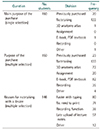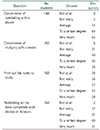Abstract
Objectives
There is a growing trend of medical students using electronic devices for studying. This paper analyzes such trend and assesses if the utilization of devices is adequate to effectively help students to study.
Methods
Survey of total 155 medical students about the usage of the electronic devices for studying during the first year of medical school was done. The answers were matched with their exam scores in the first year.
Results
Most of students were using a device, as a learning tool and the most important purpose of it was its convenience, especially for taking notes during lectures. However, students who didn't use a device when they learned anatomy or who studied with the printouts showed a tendency of receiving better scores on exams.
Figures and Tables
 | Fig. 1Average anatomy exam score of the participants who did use or did not use a device for notetaking during the lecture. Average exam score of non-users (341.4±4.28) is higher than that of device users (325.2±3.85) by 16.22 (P=0.006). *P<0.05. |
 | Fig. 2Average anatomy exam score of the participants who completely or partially or never use a device for reviewing the lecture. Average exam score of the participants who don't use a device when reviewing the lecture is higher than the rest of the groups, showing a tendency of non-device-users receiving better exam scores on anatomy. |
Acknowledgments
This work was supported by the Ewha Womans University Research Grant of 2018, and the Basic Science Research Program through the National Research Foundation of Korea (NRF-2017R1C1B1011306).
References
1. Kwon N, Lee J, Chung E, Chang G, Yoon H. Comparative analyses of the uses of information and information technologies in the everyday life of undergraduate and graduate students majoring science and engineering. J Korean Soc Inf Manage. 2013; 30:269–295.

2. Lee J, Kim Y. Examining structural relationships among self-regulated learning, flow, satisfaction, and continuous intention to use smart learning. J Educ Res. 2015; 13:127–150.
3. Ryan D. Using tablet technology for personalizing learning. J Res Spec Educ Needs. 2016; 16:1071–1077.
4. Schwab K. The fourth industrial revolution. New York: Crown Business;2016.
5. Chung JY. A study on the design of personal learning system preparing for the era of the fourth industrial revolution. Polit Educ. 2017; 24:53–72.
6. Peverly ST, Vekaria PC, Reddington LA, Sumowski JF, Johnson KR, Ramsay CM. The relationship of handwriting speed, working memory, language comprehension and outlines to lecture note-taking and test-taking among college students. Appl Cogn Psychol. 2013; 27:115–126.

7. Bui DC, Myerson J, Hale S. Note-taking with computers: exploring alternative strategies for improved recall. J Educ Psychol. 2013; 105:299–309.

9. Mueller PA, Oppenheimer DM. The pen is mightier than the keyboard: advantages of longhand over laptop note taking. Psychol Sci. 2014; 25:1159–1168.

10. Stephens A. The Benefits of hand-written versus digital notetaking in college lectures. Lexia: Undergraduate Journal in Writing, Rhetoric & Technical Communication. 2017.




 PDF
PDF ePub
ePub Citation
Citation Print
Print






 XML Download
XML Download